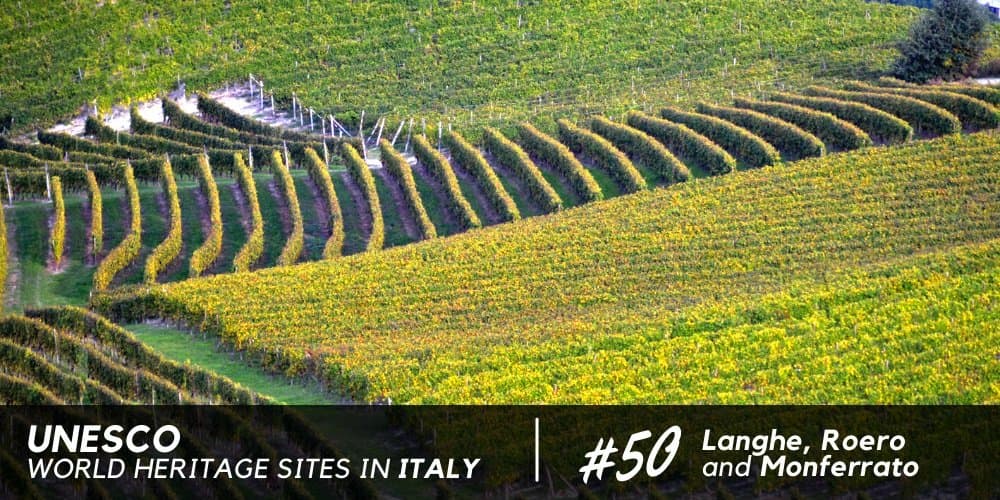Vineyard Landscape of Piedmont: Langhe-Roero and Monferrato were declared a UNESCO World Heritage Site in 2014. The beauty of these places is not only in the wonderful views offered by the sunny hills, but especially in the exceptional culture enclosed in the traditional technique of wine cultivation that takes us back centuries through the quality of the products of the earth. Barolo, Barbaresco, Asti Spumante, Barbera d'Asti, Nebbiolo and Moscato Bianco are internationally renowned wines which contribute to increase the value of this unique territory, all waiting to be discovered.

History and landscape
.png)
The vineyard landscapes are over 10,000 hectares in size. Specifically they include five distinct viticultural areas with exceptional landscapes and the Castle of Cavour. The whole area is located in the southern part of Piedmont, between the Po river and the Ligurian Apennines, a region characterized for centuries by important wine production techniques.
In the area have been found pollens of vine dated back to the fifth century BC, when Piedmont was a place of contact and trade between Etruscans and Celts; it is not by chance that Etruscan and Celtic terms, in particular related to wine, are still present in the local dialect. During the Roman Empire, Plinio il Vecchio mentions Piedmont as one of the most favorable regions for the cultivation of vine in ancient Italy.
Beyond the importance of cultivation techniques, Langhe-Roero and Monferrato offer panoramas of hills carefully cultivated and dotted with villages, castles, Romanesque churches, farms, ciabot, cellars and warehouses for the preservation and commercial distribution of wine.
The six areas between Langhe-Roero and Monferrato
.png)
The six areas that make up this important heritage are characterized by historical and naturalistic importance:
1) Langa of Barolo
It extends in the south of Piedmont. In these sunny lands is produced one of the best wines of the world, Barolo, produced since the nineteenth century and still exported all over the world.
2) The Castle of Grinzane Cavour
It is a fortification located in the province of Cuneo and dated between the thirteenth and fourteenth century. Over the centuries it has been inhabited by illustrious and noble families, but its most famous occupant was certainly the patriot of the Italian Risorgimento Camillo Benso Conte di Cavour. It is currently home to the Enoteca Regionale Piemontese Cavour and the Museum of the Langhe.
3) Barbaresco Hills
This area includes vineyards mainly cultivated with Nebbiolo grape. From this grape is produced the long aging red wine called Barbaresco. The area, which includes the villages of Barbaresco and Neive, is dominated by the evocative medieval tower of Barbaresco.
4) Nizza Monferrato and Barbera
In this area is widespread the cultivation of Barbera grape. The area is characterized by the city of Nizza Monferrato, identified as the "capital" of Barbera.
5) Canelli and Asti Spumante
This territory is mainly cultivated with Moscato Bianco, a grape used to produce the aromatic sparkling wine Asti, one of the most exported Italian white wines abroad.
6) The Monferrato of Infernot
We are in the area of Lower Monferrato where there are the "infernot": ancient cellars several meters deep and dug directly in a particular rock similar to tuff. The cellars can still be visited today and allow you to fully enter into the local culture and tradition.
UNESCO Heritage
.png)
The landscape of the central hills of Piedmont has been recognized by the UNESCO commission as a cultural landscape of exceptional beauty. The ancient historical traditions linked to the cultivation of the vine have led to the birth of a real wine culture, deeply rooted in the local community.
The motivation states that "the viticultural landscapes of Langhe-Roero and Monferrato in Piedmont are an exceptional living witness of the historical tradition of the cultivation of vine, of the processes of wine making, of a social and rural context and of an economic fabric based on the culture of wine. Their history is witnessed by the presence of a great variety of artifacts and architectures connected to the cultivation of vine and to the commercialization of wine. Vineyards of Langhe-Roero and Monferrato are also an exceptional example of interaction between man and his natural environment: thanks to a long and constant evolution of techniques and knowledge about viticulture, the best possible adaptation of vines to the characteristics of soil and climate has been achieved and they have become an international reference point. The viticultural landscapes of Langhe-Roero and Monferrato embody the archetype of the European viticultural landscape for their great aesthetic quality".
Vineyard Landscape of Piedmont: Langhe-Roero and Monferrato bear witness to a set of centuries-old traditions that have remained unchanged over time. Unesco praises the products of this territory, the sweetness of its hills and the strong link between man and nature expressed in the wonderful cultivations.
About the author
Written on 24/01/2022



Maria Luisa Ancona
The vineyard Landscape of Piedmont: Langhe-Roero and Monferrato (UNESCO) carry on a real "wine culture".